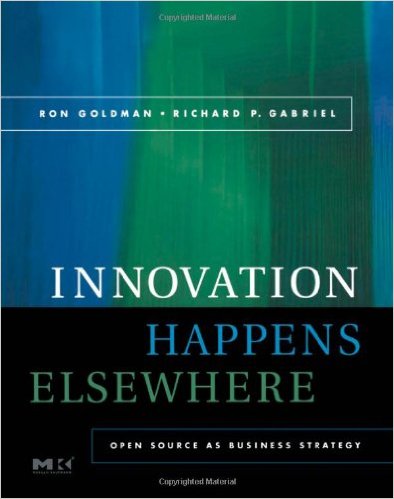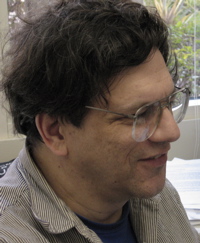
Innovation Happens Elsewhere - Open Source as Business Strategy
Focuses on what a company needs to do to make open source a part of its business. Included are examples of how companies such as Sun, IBM, HP, and Cisco Systems have successfully benefited from their use of open source.
Tag(s): Software Libre and Open Source
Publication date: 11 Apr 2005
ISBN-10: 1558608893
ISBN-13: 1558608893
Paperback: 424 pages
Views: 23,327
Type: Book
Publisher: Morgan Kaufmann Publishers
License: Creative Commons Attribution-NonCommercial-ShareAlike 3.0 United States
Post time: 02 Apr 2007 12:56:55
Innovation Happens Elsewhere - Open Source as Business Strategy
 Focuses on what a company needs to do to make open source a part of its business. Included are examples of how companies such as Sun, IBM, HP, and Cisco Systems have successfully benefited from their use of open source.
Focuses on what a company needs to do to make open source a part of its business. Included are examples of how companies such as Sun, IBM, HP, and Cisco Systems have successfully benefited from their use of open source.
Publication date: 11 Apr 2005
ISBN-10: 1558608893
ISBN-13: 1558608893
Paperback: 424 pages
Views: 23,327
Document Type: Book
Publisher: Morgan Kaufmann Publishers
License: Creative Commons Attribution-NonCommercial-ShareAlike 3.0 United States
Post time: 02 Apr 2007 12:56:55
Share — copy and redistribute the material in any medium or format
Adapt — remix, transform, and build upon the material
The licensor cannot revoke these freedoms as long as you follow the license terms.
Click here to read the full license.
Ron Goldman & Richard P. Gabriel wrote:This is an online version of our open source book based on the version published by Morgan Kaufmann in April 2005. We post it online in the hopes that people will find it useful. Feel free to link to it.
From the Introduction:
Making a public open-source project successful takes more than a press release and putting some code outside the firewall. Open source is a development methodology, but companies whose thinking stops there will find the experience disappointing. Open source is sometimes called a lifestyle, which means that successful open-source projects operate under a set of cultural conventions that may be foreign or difficult for some companies to accept. Public-open source is not a cost-saving mechanism, and it takes a careful business analysis to justify using it.
This book focuses on what a company needs to do to make open source a part of its business. This starts with understanding the business reasons for using open source and goes on to the details of day-to-day project activities. Included are examples of how companies such as Sun, IBM, HP, and Cisco Systems have successfully benefited from their use of open source.
Our examples tend to be drawn from Sun projects. The reason for this is that we have had the opportunity to observe not only the reaction of the community and pundits to company-sponsored open-source projects and the reports of people working on the inside on these projects, but also the internal discussions, pro and con, good and bad, of the decision makers. We were able to see what advice was taken and not taken, and what the results were. Sun is neither the best practitioner of open source as a business strategy nor the worst. Sun's record is spotty with some good successes and several embarrassments; the company embraces some of the fundamental tenets of openness and working with a community that are required for a successful use of open source as a strategy, but it often fails to embrace them thoroughly enough to realize all the benefits.
We do not advocate using open source blindly as a strategy, and we are not die-hard promoters of open source. We hope this book is a balanced look at the pros and cons of open source, along with tested advice on how to succeed once open source has been chosen as a part of a company's strategy.
Intended Audience:
We wrote this book to help business executives understand when and how an open-source strategy can help them to achieve their company's business goals. We also want to provide support for the managers charged with implementing that strategy in their day-to-day work running a project that makes use of open source.
The book is also aimed at the engineers who may need to work on open-source projects. We want to give them an idea of what they will experience and what will be expected of them. We also want to give them the information they will need to educate their managers and co-workers about open source.
Third, the book is for anyone interested in a better understanding of open source--its larger history, its philosophy, and its future prospects.
Interviews:
Innovation Happens Elsewhere: Part Two of a Conversation With Sun Microsystems Laboratories' Ron Goldman
Reviews:
Amazon.com
:) "I was expecting something beyond "The Innovator's Dilemma" focused on management. What I ended up with was in fact much more useful, an elementary but essential and easy to read guide to Free/Open Source Software (F/OSS)."
IBM
:) "If you, as an individual, want to get involved in an open source project or start one of your own, this is a book you need to read. If you're a manager who is considering entering the open source arena, you need this book too. It will help you navigate the sometimes rough waters of open source projects."
Slashdot
:) "This book should be at the bedside of any manager who is either delving into the open source world, wishes to understand what open source has to offer or seeks to clarify why open source as a business strategy will erode the market share of proprietary companies."
Tweet
About The Author(s)
Dr. Gabriel contributed to the development of Lisp and other infrastructure used by the artificial intelligence community. His contributions to the definition of the Common Lisp Object System set the stage for many object-oriented language features that were ahead of their time. He helped to develop Smalltalk and other infrastructure used by the object-oriented programming community, and has been influential in the ACM OOPSLA conferences, for which he created the Onward! Track to look for the next big advance in object technology.

Dr. Gabriel contributed to the development of Lisp and other infrastructure used by the artificial intelligence community. His contributions to the definition of the Common Lisp Object System set the stage for many object-oriented language features that were ahead of their time. He helped to develop Smalltalk and other infrastructure used by the object-oriented programming community, and has been influential in the ACM OOPSLA conferences, for which he created the Onward! Track to look for the next big advance in object technology.
Ron Goldman is a researcher working at Sun Microsystems Laboratories on alternative software development methodologies and new software architectures. His OOPSLA 2006 paper "Conscientious Software" (co-authored with Richard P. Gabriel) explored ways to make software more robust—drawing on ideas from Biology and Complexity Science.

Ron Goldman is a researcher working at Sun Microsystems Laboratories on alternative software development methodologies and new software architectures. His OOPSLA 2006 paper "Conscientious Software" (co-authored with Richard P. Gabriel) explored ways to make software more robust—drawing on ideas from Biology and Complexity Science.